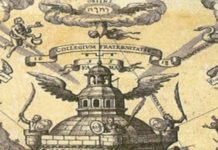The island of Avalon belongs to the realm of the imagination, yet its location has been eagerly sought. The discovery of what many believe is the grave of King Arthur has linked it inextricably with the English town of Glastonbury. The Celtic mythology refers to Glastonbury as ‘Isle of Grass’ when it was almost an island. The remains of Iron age lake villages nearby confirm that this area of Somerset once lay under water and boats could have sailed to Glastonbury. The Tor rose from undrained marshes covered in sheets of water that reflected the sky.
Many of the Celts believed that the dead lived on and that their saints and heroes were transported after death to the idyllic island of Avalon. Consequently, when the 12th century scholar Geoffrey of Monmouth came to write his popular History of the Kings of Britain, he linked Avalon with the Celtic hero King Arthur. According to Geoffrey, the mortally wounded king was borne by barge to Avalon, where his sister, the sorceress Morgan le Fay, promised to heal him if he stayed with her.
The Celts envisaged the dead as living on a distant island, which is probably how the Avalon legend arose. This belief led to the practice of burying the dead on islands. One sixth-century historian wrote that Britain served as such a place for the Franks. Bardsey Island, off the coast of North Wales, was another burial ground, reputed to contain the graves of 20,000 saints. Glastonbury, which was once virtually an island, may also have been a burial place for the dead.
The Arthurian legend in addition asserted that one day Arthur would return to liberate the Welsh from the yoke the English kings: after all, was he not the once and future king? The chronicler William of Malmesbury, in common with other early commentators, wrote in 1125 that Arthur’s place of burial “is nowhere to be seen, whence ancient rhymes fable that he is yet to come.”
The English kings of the 12th century were faced with an unruly Welsh nation which openly espoused the hope that Arthur would return from Avalon and defeat the royal oppressors. In particular, the Plantagenet King Henry II felt it would be prudent to dash these hopes once and for all by finding Arthur’s burial place, thereby proving beyond doubt that the Celtic hero was dead. Henry had been told that Arthur might be buried at Glastonbury and instructed the Abbot of Glastonbury to start searching for Arthur’s grave.
The monastery at Glastonbury, founded early in the eight century, became a Benedictine house in the tenth century. In 1184, the abbey was destroyed by fire and Henry II initiated its reconstruction. But Henry died in 1189, and soon afterwards the monks – perhaps prompted by a financial crisis – began to dig, hoping to find relics of Arthur that would bring fame and fortune to their abbey.
What the monks discovered must have seemed highly satisfactory to those who were keen to link legend with reality. Working behind curtains, the diggers reached a depth of 7ft (2m) and finally found what they were looking for: a stone slab and a lead cross on which was inscribed Hic iacet sepultus inclitus rex Arturius in insula Avalonia (‘Here lies buried the renowned King Arthur on the isle of Avalon’). Deeper still was an oak tree hollowed out in the shape of a coffin, inside were two skeletons: one tall with its skull smashed by a heavy blow, the other smaller and with a fragment of blond hair still attached. Surely these were the bodies of King Arthur and his beloved queen. Guinevere? The monks must have been truly rejoiced, for the discovery of the tomb would once again draw pilgrims to Glastonbury and help fill their dwindling coffers. An additional bonus was that the burial clearly linked Glastonbury with the legendary island of Avalon, an identification which has become an accepted part of the abbey’s tradition.
The bones were placed in two caskets, painted with the portraits of Arthur and Guinevere and their coats of arms, and were added to the abbey’s treasury of relics. In 1278, while in the process of subduing the Welsh, King Edward I had Arthur’s bones removed from the casket and put on display as a reminder that the king was dead and would not come again. They were then transferred to a tomb and placed in front of the high altar, where they remained until the dissolution of the monastery in 1539.
It is tempting to suppose that the discovery of the two bodies was engineered by the abbot to raise funds for the rebuilding of Glastonbury Abbey. The story is, however, backed by archaeological evidence. In 1934, the remains of the empty second tomb were found where the high altar once stood, and a plaque now marks the spot. A second archaeological excavation, led by Dr. Ralegh Radford in 1962, rediscovered the original grave and confirmed that a cavity had existed there; but it could find no evidence as to the grave’s occupant. This site lies some 50ft (15m) from the south door of the Lady Chapel.
The lead cross originally found at the grave has also given rise to doubts. There are several different versions of the inscription on the cross, which disappeared more than 200 years ago. Early descriptions say it mentioned Guinevere as well as Arthur, but a drawing of the cross in William Camden’s Britannia in 1607 makes no mention of the queen’s name.
It has been suggested that the cross was made by the monks in 1190, but this is hard to accept. The lettering is crude and points to an earlier date while the Latin version of Arthur – Arturius – was not in use at that time and has only been found in a seventh-century document. If the cross was a fake, its maker was remarkably consistent.
Mystery also surrounds the final resting place of the cross. It survived the Dissolution and 200 years ago was known to have been in the possession of a member of the clergy at Wells Cathedral. The rediscovery of the cross, which is by no means impossible, would open up the whole debate again.
In 1935, a storm of controversy followed the publication of a book, A Guide to Glastonbury’s Temple of the Stars, written by the English sculptress Katharine Maltwood (1878-1961). The author claimed to have discovered a group of huge figures outlined by the natural contours and man-made features of the Somerset countryside in a 30 mile (48km) circle around Glastonbury. She believed that the area’s hills, watercourses, ancient tracks, and earthworks represented the twelve signs of the zodiac, with the 525ft (160m) Tor itself as the zodiac’s centre. By the association of place names and legends, she then linked the whole zodiac with the story of King Arthur.
There are many stories and traditions associated with Glastonbury and its ruined abbey. Joseph of Arimathea was supposed to have settled in Glastonbury, and both King Arthur and St Patrick are said to be buried in the abbey grounds. Legend has it that Glastonbury Tor was once the entrance to a realm of the underworld.
Glastonbury is an ancient site which has always been imbued with myth and legend. In pre-Christian times, pagan rites were practiced on Glastonbury Tor, and excavations have uncovered traces of Christian buildings that pre-date the foundation of the monastery. Legend has it that the early church, or ‘Old Church’, was built by Joseph of Arimathea, the rich man who wrapped up the body of Jesus and carried it to his own tomb. Joseph’s staff was supposed to have taken root and become the Glastonbury Thorn, which still flowers at Easter and Christmas in the abbey grounds. With such a history, it seems fitting that Glastonbury should provide the setting for Arthur’s death and the identification with Avalon.
-end-




































